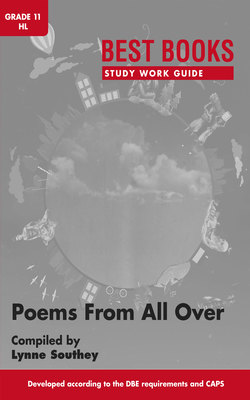Читать книгу Best Books Study Work Guide: Poems From All Over Gr 11 HL - Lynne Southey - Страница 17
На сайте Литреса книга снята с продажи.
In a Station of the Metro by Ezra Pound
Оглавление(See p. in 27 Poems From All Over)
| Title: | The title situates the poem in an underground station used by commuters in a city. |
| Theme: | There is beauty in people even in the drab urban city. |
| Mood: | Appreciative, observant, thoughtful. |
Discussion
The haiku links faces in a crowd in the metro to the petals of flowers. These are two very different, unlike things and part of the delight of the poem is their juxtaposition (placing together). The poet does not write that the faces look like petals, he leaves that connection to the reader to make. There is also no speaker in the poem, there is no person looking at the faces and thinking that they look like petals.
The reader is not sure if the petals have fallen off the flowers and are stuck to the dampness of the branch, or if the branch has flowers growing from it. Flowers, like people, live for a while and then die. The life of both is transient and not permanent.
The two-lined poem is remarkable in the complexity and richness that it conveys, far more than the fourteen words would seem able to contain.
Background information
Look at this photograph of the blossoms of a cherry tree which grow in Asian countries. A haiku is a Japanese form of poetry – some of Ezra Pound’s work seem to be influenced by Japanese and Chinese culture. (Hanami is traditionally feasts under these trees which celebrates cherry [and plum] blossoms that start to bloom.) Look at Suzuki Harunobu’s painting, Woman admiring plum blossoms at night. Do you see how the petals are falling off the trees?
Analysis
| Lines | Comment | |
| 1 | Faces appear in a crowded station on the metro, an underground train system in Paris. | “[A]pparition” normally means a ghost, but here it is also linked to ghostly appearance, as if the faces suddenly materialised. (“[F]aces” standing for entire people is an example of metonymy, by which the part stands for the whole.) Notice the “The”, which is the definite article, making the apparition particular rather than using “An”, which would be something that happens often perhaps. The “The” implies a sudden realisation of what the faces are like. The title has told us the crowd is made up of commuters catching trains, the underground is dark and lit artificially, which could also give a ghostly glow to things.Notice also “these” particular faces in full view now. This adds to the fleetingness of the experience. |
| 2 | This reads like a title or heading or caption to a picture. Only the fact that it is the second line of a two-line poem causes us to see that there must be a connection and to look for it. The faces of the first line are like the petals of a flower. The alliterated (repeated initial letters) “black bough” is in contrast to light, colourful petals. | Flowers are beautiful, their petals light, fragrant and colourful. By juxtaposing faces and petals, the poem is comparing them, thus saying the faces too are beautiful. Perhaps the “wet black bough” refers to the underground tunnel of the metro, or the solidity of things in contrast to the petals’ lightness, or even the grime and mechanisation of a city.How does one react to these images? How was the poet reacting to the sudden insight of what he was looking at? These are questions the poem asks of its reader. |
Contextual questions
1.Flowers and people have brief lives. In what way does the poem support this statement? (2)
2.How does the lack of verbs in the poem affect one’s understanding of it? (2)
3.Rewrite the haiku adding appropriate verbs. How does this change the impact of the poem? (3)
4.The note in your anthology states that attention is drawn “to the fact that beauty still exists in people despite stark environments”. State in what way you agree or disagree with this. (3)
(10)
| Enrichment activityLook up other haikus and read them. Look at how this haiku is typical of the form. |
